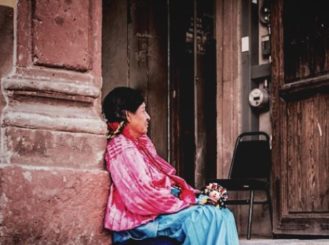
As an adopted person I’ve lived with the reality of a hidden history. My origin story remains unknown to me, sealed by a court order for almost 50 years now. I know little about my mother—just that she was Mexican and an accountant at the time of my birth. When I was three months old my parents adopted me. Even though my adopted mom is also of Mexican heritage, I was basically raised as a white evangelical.
Growing up we always had tortillas and hot sauce in the house. A favorite family appetizer was guacamole and chips. This wasn’t because we were Mexicans, but because we were Californians. We also loved steam artichokes, garlic bread and a variety of olives. I don’t remember ever feeling Mexican; it wasn’t an identity marker for me even though it was the only thing that connected me to my birth mother. I was a California girl. (But not in a Katy Perry kind of way.)
Many years later I enrolled in Fuller Theological Seminary, an interdenominational seminary where Methodists, Presbyterians, Baptists and even a few Catholics studied right alongside evangelical charismatics like me. The diversity of voices and experiences energized me. We contributed our various traditions and interpretations to the conversations. Our learning was textured with complexity and it drew me closer to the truth. This might be the root of my self-description as ecclesiastically promiscuous.
Even at Fuller there was so much whiteness. All my professors were white and every required reading list I can remember featured white men. No one introduced me to Gustavo Gutierrez, Leonardo Boff or Jon Sobrino. Liberation theology was mentioned in passing with disdain and in connection to Marxism. Also missing from the curriculum: James Cone, Howard Thurman, Ada María Isasi-Díaz. Maybe if I studied in the School of World Mission (as it was called back then) I would have been exposed to more diverse scholars. But as a student pursuing the standard Masters of Divinity, conversance in liberation theologies or engagement with thinkers of color wasn’t considered essential. I became more committed to denominational diversity, but graduated as a product of white theology.
All my professors were white and every required reading list I can remember featured white men. No one introduced me to Gustavo Gutierrez, Leonardo Boff or Jon Sobrino.
Much later in life, in the state next door, I wandered back into the Catholic Church one Ash Wednesday. It felt like home—the flickering vigil candles at the feet of Mother Mary’s icon, the faint aroma of incense that hung in the air, the basin of holy water. The prayers were familiar, even though I had not said them since my childhood. I was reciting the liturgy like the first phone number you memorized and can never forget. It was rote and yet from a deep cavern in my heart. You see, before my parents joined an evangelical church they were Catholics and we attended St. Nicholas Church every Sunday. That Wednesday in the cathedral I reconnected with my Mother Church.
I wish I could recall who first encouraged me to read A Theology of Liberation, the seminal work by Gustavo Gutierrez. All I remember is reading it one summer in Burundi and underlining almost every paragraph. Years later, I had an epiphany of sorts. I looked across my shelves of books and noticed that so many titles were from the liberation canon. There were many from Latin America, obviously, but also there were volumes on black liberation, Palestinian and Indigenous works of liberation, books by feminists and womanists and mujeristas (Latin American women liberation theologians)—all writing about freedom. It occurred to me that so much of my own theological understanding was rooted in the liberation narrative of Exodus—men and women working toward freedom. I owned stacks of commentaries on Exodus and never tired of reading more, imagining more freedom for all of us. And there it was. In the middle of my living room I realized that I was a liberation theologian.
It occurred to me that so much of my own theological understanding was rooted in the liberation narrative of Exodus—men and women working toward freedom.
How did I stumble into liberation theology? Maybe it was a chance reading. Maybe it was living and working in Burundi where the hunger for freedom from extreme poverty took on a tangible quality. It could be the words of Isaiah haunting me: Good news is for the poor, it’s releasing prisoners, recovering sight for the blind, letting the oppressed go free. And then Jesus saying that this jubilee ministry was his mandate on earth—setting people free from all kinds of oppression. It must be the convergence of this, and more, that brought me to see the world through a liberative lens.
Next I picked up Mujerista Theology by Ada María Isasi-Díaz. It was with great intention that I started reading a Latina liberation theologian. Her story drew me in and her thinking challenged me. But her final chapter was like yeast rising, finally revealing an unexpected fullness. She spoke of the way Latinas practice their faith—lighting candles to keep vigil, creating space for Mother Mary in their home, and holding a rosary as they pray. She was describing me.
When we moved into our first home, I bought a statue of Mary. I didn’t go looking for the Madonna. Instead, the sable-color mother caught my attention among all the other Mexican artwork. She became the first guest in our home. I set up an iconostasis where I hung my collection of icons: The Holy Trinity by Rublev; Jesus rising from the tomb; John the Baptist, Peter and Paul embracing in reconciliation. I lined up blue-glass votives in my office and lit them when I prayed and when I wrote. I bought a rosary, not owning one since my auntie gave me one as gift for my First Holy Communion, so I could pray the rosary before mid-week mass. I thought this merely my way of embodying my faith, slowly developed over years of following Jesus.
But when I read about the substance of Latina practice, I found myself in the company of my Hispanic sisters. “I’m more Latina than I thought,” I wrote in the margin of Mujerista Theology after reading the final page.
Now I see a deeper convergence—liberation theology rooted in Latina American Catholicism and all of that as my biological inheritance. Liberation is in me like the Latin blood in my veins. Even if I was not raised with my Mexican heritage, it was encrypted in me. It is like my mother hid the yeast in my tiny body at birth, and like all hidden things, it came to light at the appropriate time. Now I see more of my full identity.
Even if I was not raised with my Mexican heritage, it was encrypted in me. It is like my mother hid the yeast in my tiny body at birth, and like all hidden things, it came to light at the appropriate time.
This is only the beginning of this story, but I don’t have time to share the rest here. Maybe someday I will tell you about the moment I realized that despite my white upbringing, I was a woman of color, a mujerista. Maybe I will tell you how it was a baptism of tears at the hands of my hermanas, who welcomed me into their arms as they gently dismantled my dissonance and called me out of hiding.
Kelley Nikondeha is codirector and chief storyteller for Communities of Hope, a community development enterprise in Burundi, and cofounder of Amahoro Africa, a conversation between theologians and practitioners. She and her husband Claude, along with their children Justin and Emma, split their time between Burundi and the US. This article originally appeared on SheLoves Magazine, and is reprinted here with permission.


